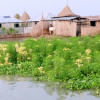Did the Dohazari-Cox's Bazar rail line worsen floods?

Southern Chattogram, including areas such as Bandarban and Cox's Bazar, is experiencing devastating floods due to a week-long spell of incessant rainfall. While heavy rains and the overflow of hill water into rivers and canals are typical climatic events in this region, the recent flood was exceptionally catastrophic. This disaster has raised questions about the role of the newly constructed Dohazari-Cox's Bazar railway line in exacerbating the crisis.
The flood significantly affected areas through which the railway line passes, such as the upazilas of southern Chattogram, namely Chandanaish, Satkania, and Lohagara. Some upazilas of Cox's Bazar, including Chakaria, Pekua and Ramu, were also impacted by the floods. All of this has prompted the need for a comprehensive analysis of the current circumstances.
The hydrological dynamics of the region are distinctive, with natural water patterns varying across different seasons, much like in haor areas. The canal-river system of southern Chattogram is characterised by water primarily flowing in from hills. These canals wind through expansive marshlands, and the marshes serve as pathways for the heavy water flow of the hills. These trails are not visible during the dry season. But during rainfall, these invisible trails in the marshlands serve as reserves to contain excessive water from the canals. This constitutes the hydrological rhythm of southern Chattogram.
However, recent developments have introduced a new dynamic. The under-construction rail project has unintentionally created an obstacle for the natural water flow in the region, resulting in water levels reaching heights of three to five metres across the landscape. Although the project did incorporate bridges and culverts designed to facilitate water passage, it would be interesting to see how a limited number of small culverts could manage the level of water flow typically handled by a vast expanse of marshland. On the other hand, some of the culverts are misaligned with the natural water flow. In certain instances, culverts have been allocated in areas where water rarely passes through. This highlights a lack of thorough environmental assessment during the project's inception. It is also evident that the project authorities lack an adequate understanding of southern Chattogram's age-old water dynamics.
But the crises emerging from the Dohazari-Cox's Bazar railroad project do not end here. The railway line runs from north to south, intersecting numerous east-west roads that are equipped with dual-sided culverts for effective water drainage. These roads now face a challenge. The culverts, originally designed to direct water from one marshland to another, now find themselves bisected by the railway, dividing the marshlands into sections on both east and west. As a result, only one culvert is available for water drainage, but the marshland has been split into two by the rail track. Consequently, either the western or eastern part of the marshland experiences blocked water flow. This interruption of water flow shows how major development projects can inadvertently restrict or even damage pre-existing infrastructure.
The railway project has left an impact on smaller water bodies, too. A canal near my own house, for example, has disappeared after the construction of part of the project nearby. Consequently, even minor downpours now trigger unusual levels of stagnation – a phenomenon that the area's residents have not faced before.
The grand ambition of the Dohazari-Cox's Bazar railway project is to enhance regional connectivity. But this has been clouded by the unforeseen consequence of waterlogging. Currently, discussions about constructing several bypasses in southern Chattogram are underway. But given that the railway project has already disrupted the natural water flow of southern Chattogram and Cox's Bazar, the new bypasses could further worsen this issue.
Of course, the railway project alone cannot be blamed for flooding in southern Chattogram. While the canals serve as reservoirs during heavy rainfall in the hills, over time, the smaller canals have been encroached upon. Since these canals depend on mountain-sourced water, they remain dry for a significant portion of the year. And this scarcity has led to a perception among the populace that these canals are redundant. Consequently, they have been encroached upon and are now susceptible to inundation even by light monsoon rains. On the other hand, deforestation in the mountainous regions and the occupation of watersheds have led to a change in the climate and disrupted the natural course of water. This upheaval has made flooding practically inevitable.
Unfortunately, the lack of emphasis on environmental study, typical water courses, and the climate of the Chattogram region when planning and executing the railway project has now resulted in an intensely waterlogged situation.
In light of the ongoing climate crisis, it is imperative that we exercise heightened caution when embarking on large-scale development projects. These ventures are designed with the future in mind, often spanning a century. While some disruptions in water flow might occur as a consequence, environmental scientific evidence indicates that these flows tend to reinstate themselves within a 15-to-25-year time frame. Therefore, it is not only essential to heed the knowledge provided by the environment, but to also keep in consideration local histories that can provide insights into the characteristics of a region's natural environment.
Shahadat Hossain is a research scholar in the Department of International Relations at South Asian University in New Delhi.

 For all latest news, follow The Daily Star's Google News channel.
For all latest news, follow The Daily Star's Google News channel. 











Comments